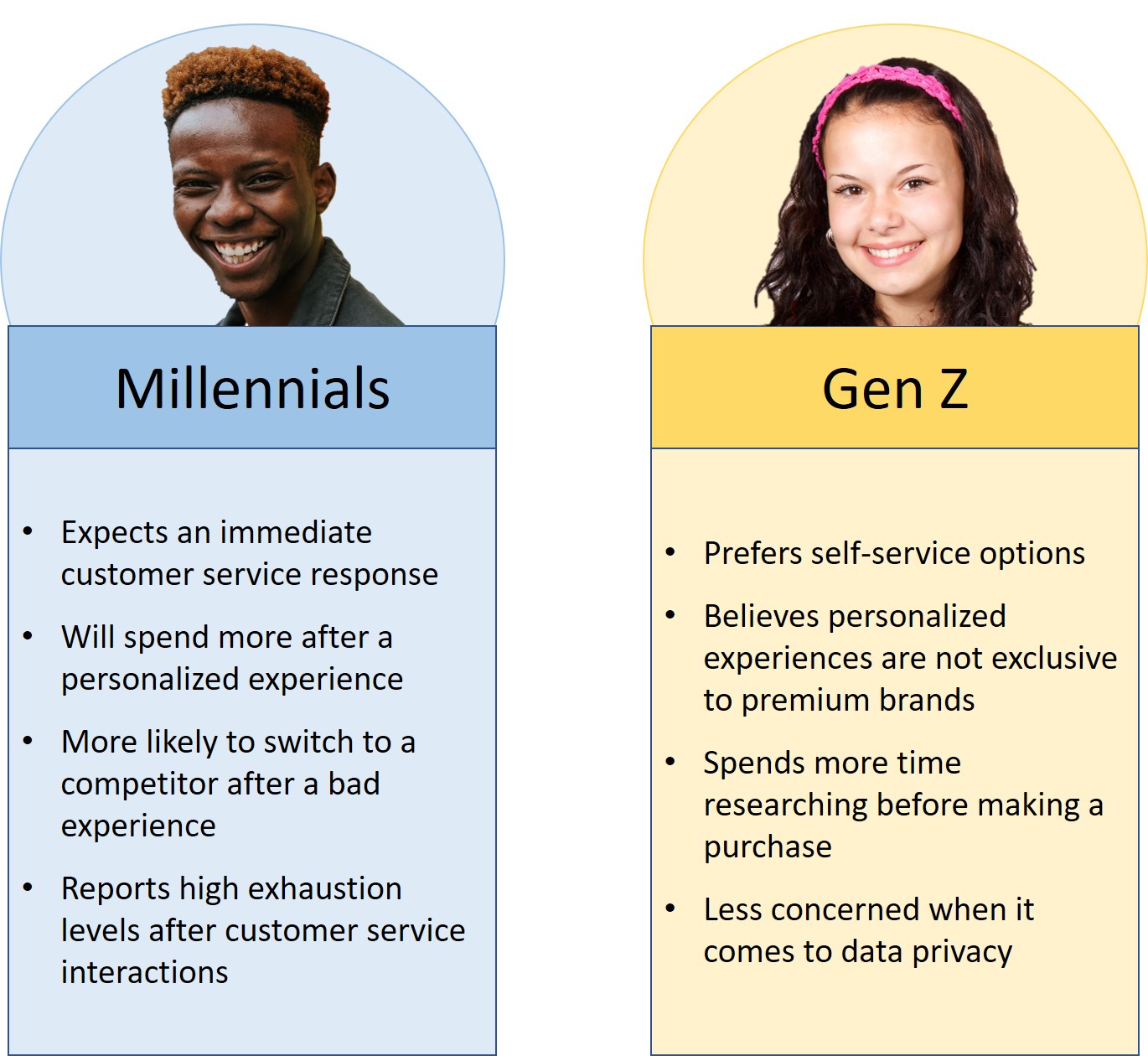Customers Want Personalized Service
Chapter 2 Learning Outcomes
After reading this chapter, you should be able to do the following:
- Discuss how customers want personalized experiences.
- Discuss how the expectations from different generations.
Customers Want Personalized Experiences
Consumers today view personalization as the default standard for engagement; they want companies to recognize them as individuals and know their interests. Companies that offer these experiences are able to differentiate their brands and create a competitive advantage.
Personalization has become integral to the customer journey and is now a key driver of brand loyalty across all channels. Consumers are much more likely to buy from brands, both in-store and online when offers are personalized. Consumers are also interested in purchasing more personalized products and services and are willing to wait longer to get them.[1]
Forty-eight percent of consumers spend more when their experience is personalized. Seventy-four percent of people dislike being shown irrelevant content. So what does this say about personalization? In customer experience, personalization is a winning strategy that can help companies advance their relationship with customers. Eighty-eight percent of marketers claim that they’ve seen a measurable improvement in their businesses after implementing customer experience personalization tactics.[2]
Personalized Customer Experiences for Millennials
Millennials, sometimes known as Generation Y, is a demographic cohort that follows Generation X and proceeds Generation Z. Millennials were born between 1981 and 1996 (although this age range may vary depending on the source). So as of 2023, the millennial age range is between 27 and 42. They were the first generation to grow up in the Internet Age but also remember life before social media. They have lived through not one but two generation-defining recessions and have been noted for craving work-life balance.[3]
The customer experience for millennials means experiencing something genuine and incredible that will build lasting memories. Therefore, businesses market their products in such a way that will show millennials how their experience will be better as a result of purchasing from that brand. For instance, if a company sells luggage and is marketing a new suitcase, the company will not just market the suitcase, instead it will market the experiences and trips around the suitcase, thereby making the product a part of a bigger experience.[4]
Personalized Customer Experiences for Gen Z
Generation Z, sometimes known as “zoomers,” is the demographic cohort that comes after millennials and proceeds Generation Alpha. Members of the Gen Z years were born between 1997 and 2012. So as of 2023, the Gen Z age range is anywhere from 11 to 26. They are commonly referred to as the first fully “digitally native” generation. They grew up with social media and smartphones—they’re used to living in a digital-first world. Research from the National Library of Medicine shows that this diverse generation is highly motivated and more risk-averse than previous generations.[5]
Generation Z spends most of their time online, in fact, close to three-quarters of these consumers choose to spend their free time on the Internet. They value the ability to solve issues on their own, and they find it one of the most frustrating bad customer service experiences when they cannot find the information they need online. They may be young, but these consumers have colossal buying power. Uniquely Gen Z influences everything from their families’ food purchases to clothing, electronics, household goods, and even furniture. Gen Z is very cyber-savvy and very savvy in general, and just because they are young companies need to be careful not to underestimate them or treat them as young and inexperienced. Rather, businesses should bear in mind that Gen Z’s perception of customer service is that things should be frictionless, which is unlike that of any other generation. Their world is one of immediacy and convenience, and they want their interactions with businesses to be just as seamless. This expectation extends from making a purchase to the customer experience overall.[6]
Differences Between Millennials and Gen Z
Refer to Figure 1.1 below for a comparison of the customer experiences expectations and preferences of Millennials to Gen Z.

- IBM Watson Marketing. (2019, February 19). Personalizing Customer Experiences at scale: How human creativity and AI-based automation make a winning combination. Marketing Land. https://marketingland.com/personalizing-customer-experiences-at-scale-256563 ↵
- Atif, M. (2019, May 30). Reinventing personalization for customer experience. Toward Data Science. https://towardsdatascience.com/reinventing-personalization-for-customer-experience-235d8c75aa38 ↵
- Gorynski, M. (2023, September 1). Millennials vs. Gen Z: Differences in customer service expectations. https://www.zendesk.com/blog/millennials-vs-gen-z-customer-service-expectations-compare/#:~:text=Though%20Gen%20Z%20and%20millennial%20customer%20service%20expectations,prefer%20using%20digital%20channels%20to%20contact%20customer%20support. ↵
- clincher. (n.d.). What do millennials care about? It’s not what you think. https://eclincher.com/what-do-millennials-care-about-its-not-what-you-think/ ↵
- Gorynski, M. (2023, September 1). Millennials vs. Gen Z: Differences in customer service expectations. https://www.zendesk.com/blog/millennials-vs-gen-z-customer-service-expectations-compare/#:~:text=Though%20Gen%20Z%20and%20millennial%20customer%20service%20expectations,prefer%20using%20digital%20channels%20to%20contact%20customer%20support. ↵
- Telus International. (2017, June 15). Customer service for Gen Z: How to connect with the next power generation. https://www.telusinternational.com/insights/customer-experience/article/customer-service-generation-z ↵
has become integral to the customer journey and is now a key driver of brand loyalty across all channels. Consumers are much more likely to buy from brands, both in-store and online, when offers are personalized.
sometimes known as Generation Y, is a demographic cohort that follows Generation X and proceeds Generation Z. Millennials were born between 1981 and 1996 (although this age range may vary depending on the source).
sometimes known as “zoomers,” is the demographic cohort that comes after millennials and proceeds Generation Alpha. Members of the Gen Z years were born between 1997 and 2012. So as of 2023, the Gen Z age range is anywhere from 11 to 26. They are commonly referred to as the first fully “digitally native” generation.

